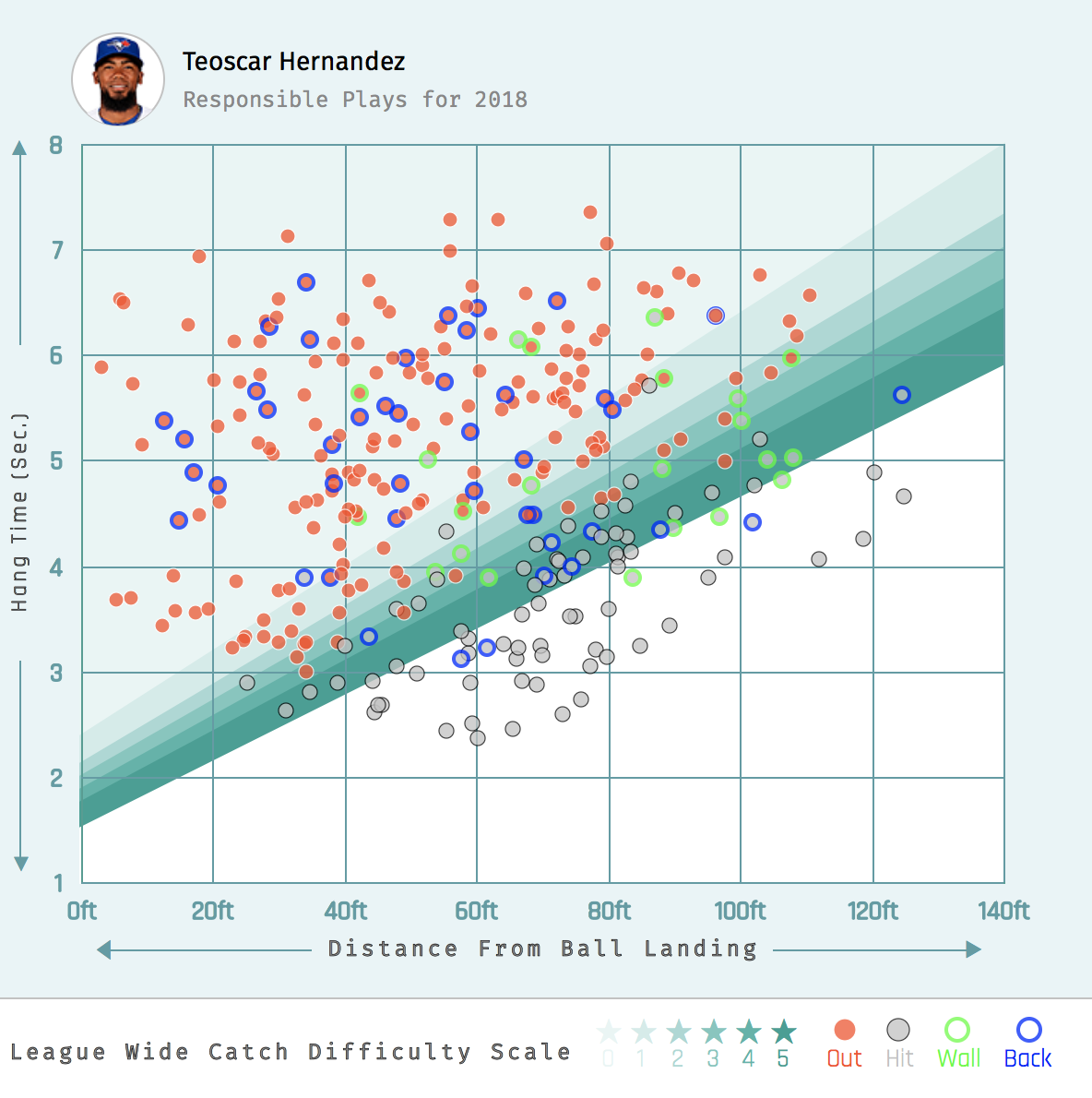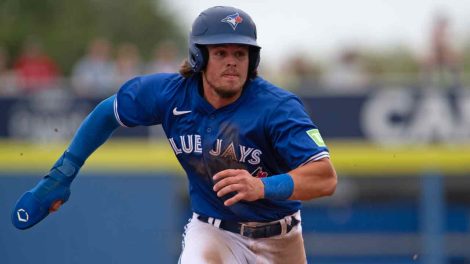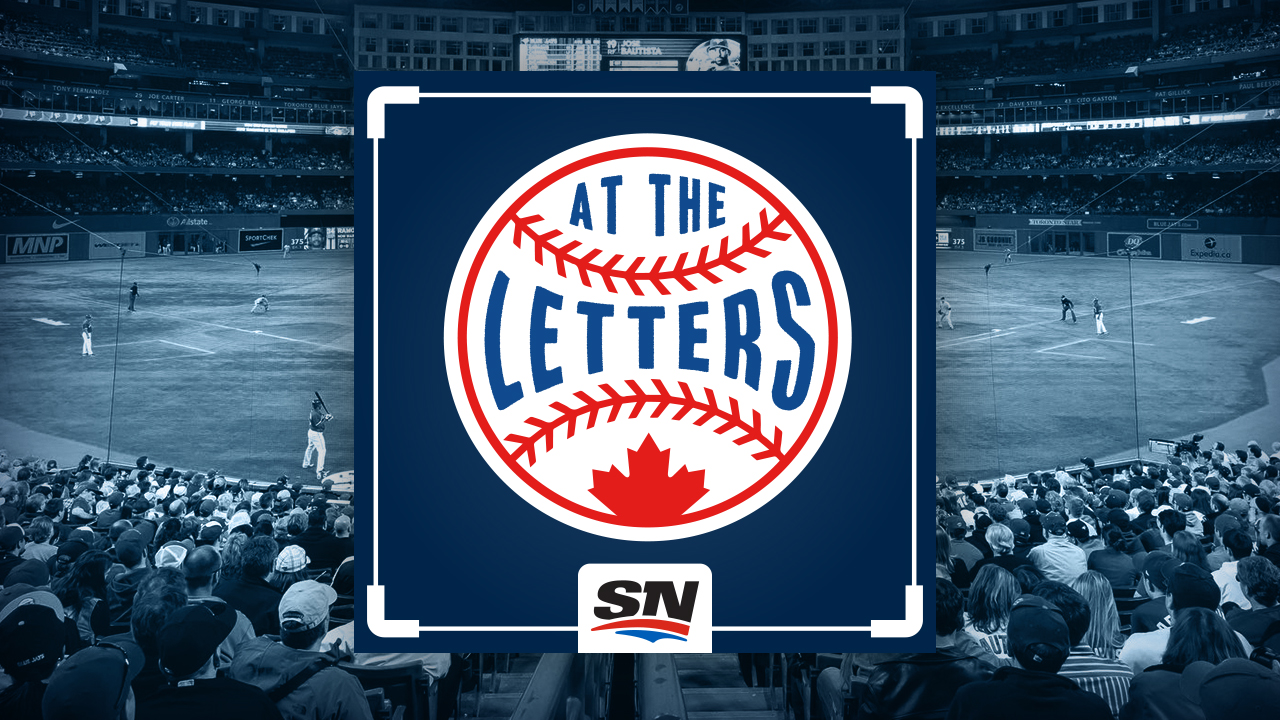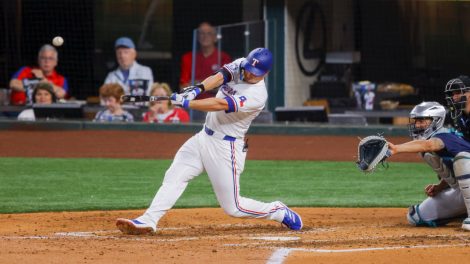At the end of the 2018 season, Teoscar Hernandez returned to his Dominican Republic home and gave himself a month off. He’d just completed his first full big-league season with the Toronto Blue Jays – 134 games in which he’d batted .239/.302/.468 with 22 home runs and endured a handful of defensive misadventures in the outfield.
He needed to decompress.
Still, before the four weeks were up, the 26-year-old outfielder was done with sitting around, eager to prepare for some winter ball with the Toros del Este. That’s about as long as he could go without playing any baseball.
That’s why even in his downtime, Hernandez only managed to shut off physically, not mentally. He could have obsessed over what went wrong – the ghastly 163 strikeouts, the eight errors, the routine plays gone terribly awry. Wisely, he focused on ways to address his shortcomings. There were two holes in his plate coverage – on fastballs up and in, and breaking balls down and away – that had been exposed. In the field, his reads of balls and route efficiencies were trouble spots. Mid-season adjustments on both fronts were too hard to make amid the daily demand for production.
The time off provided the clarity needed to develop a plan.
“When you go for the first time, let’s say, to a battle, to a war, you don’t know what’s out there,” explains Hernandez. “If you’ve been there, you know what it takes to stay safe and (survive) a long time doing the same thing, and doing it pretty well. … With experience, you know how to control the bad moments. You don’t know what it takes until you do it.”
In the aftermath, he had those insights, so by the time new hitting coach Guillermo Martinez and new first base coach Mark Budzinski paid him a get-to-know-you visit in December, the plans Hernandez will take into the 2019 season were already in place. And if some of what he showed during a strong spring training carries over, Hernandez’s growth may very well emerge as one of the most important developments of the year for the Blue Jays.
“The biggest thing is confidence … but you can’t just ask for it,” says general manager Ross Atkins. “That comes from preparation. That comes from consistency of routines. Teo’s done a great job of improving not just his daily routine, but his pre-pitch routine both as a defender and an offensive player.”
***
Periods of struggles for players transitioning to the big-leagues are common and should be expected – rarely do prospects travel a linear path from the minors to majors. But perhaps the impressive way Hernandez began his Blue Jays career after his acquisition from the Houston Astros for Francisco Liriano just before the 2017 trade deadline skewed expectations.
As a September call-up that year, he eight homers and six doubles in 26 games. Then, after being called up in early April last year, he batted .306/.377/.677 in his first 15 games and looked like a saviour capable of pulling a team on the edge of a cliff back from the brink. But then he levelled off, and then he struggled, and then things snowballed.
“Defensively, he got caught up in the moment, maybe, in his own head a little bit, which caused him to make some mistakes out there,” says right-fielder Randal Grichuk, who managed to rescue his 2018 after a dreadful start, helped by a stint on the injured list that allowed him to rework his swing.
Hernandez’s time out didn’t come until the off-season. And when Martinez and Budzinski arrived in the Dominican Republic, he’d already started working on his adjustments.
What he told Martinez is that he’d started to understand how pitchers were attacking him, and that he needed to learn how to get at the high fastball. Last year, of the 2,109 pitches he saw, 1,218 of them were fastballs. He swung through 199 of them. The vast majority of those were in the upper part of the zone.
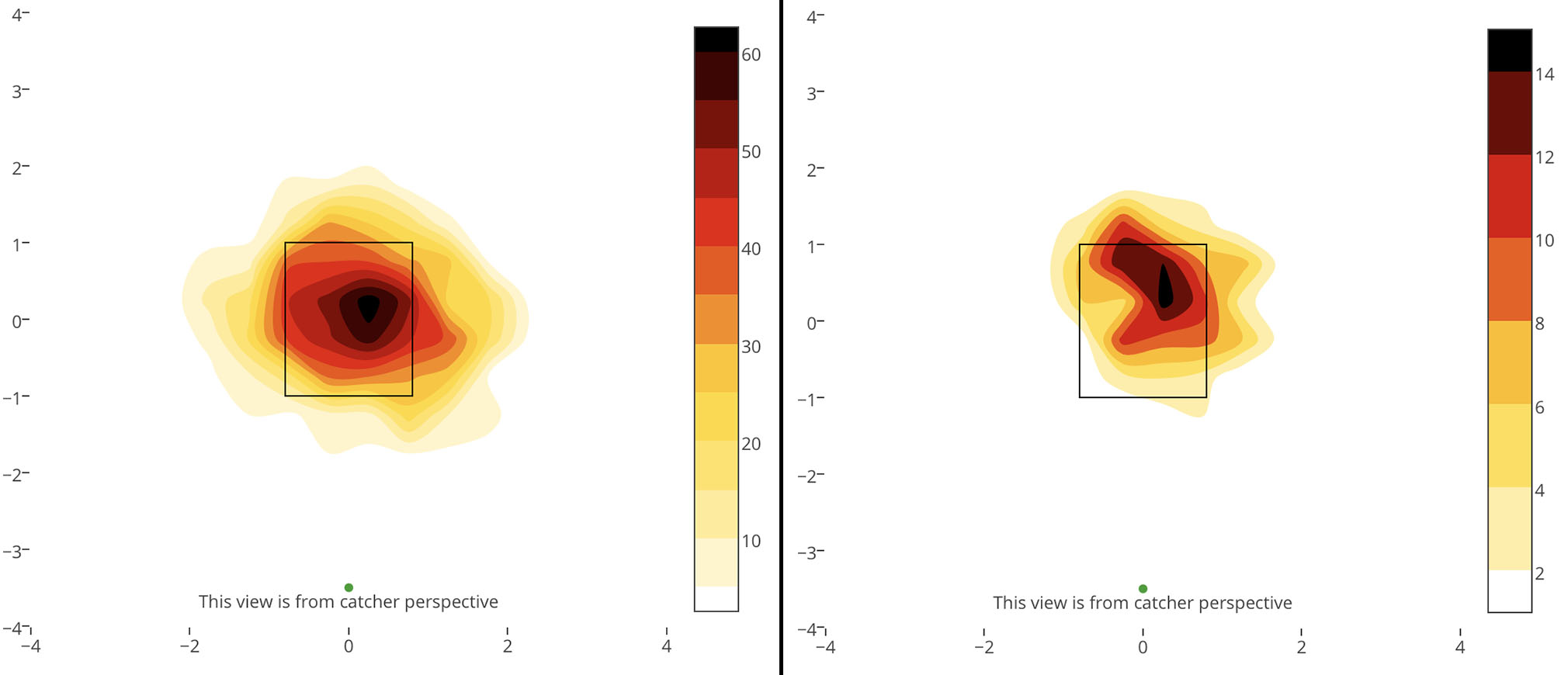
(Left: Teoscar Hernandez’s fastball heat map. Right: FB swings and miss. credit: Baseball Savant)
That exposure left him vulnerable to breaking balls down and away. Of the 891 breaking and off-speed pitches he saw, he swung through 203 of them, most of the chase variety.
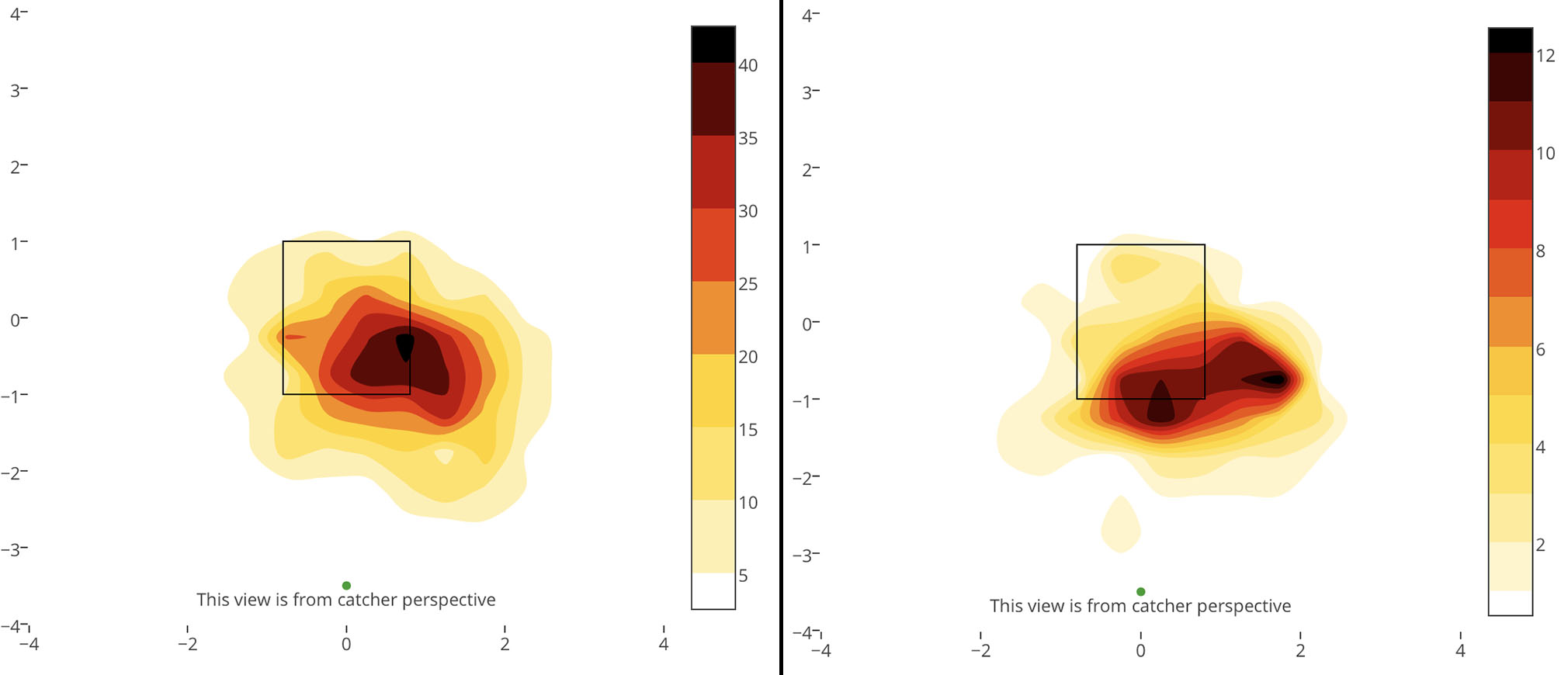
(Left: Teoscar Hernandez’s breaking ball heat map. Right: breaking ball swings and miss. credit: Baseball Savant)
To counter both trends, Hernandez came up with a variety of drills aimed both at helping his discipline as well as adjusting his swing path to ensure better zone coverage. He’ll do things like hit with a fungo bat rather than his game bat to better practice striking the ball just right. He’ll set up a pitching machine between the mound and the batter’s box, turn up the speed super high, and then move closer and further to the release point, a tactic Grichuk employs as well.
“It’s for my reaction, to try and not swing at bad pitches,” says Hernandez. “I’m trying to stay with the things I need to do and just use my hands to control the barrel to where the ball is.”
Martinez uses the word “amazing” to describe Hernandez’s routine and believes that once he shows teams “he can get there,” on the high fastball, it will force them into parts of the zone where he does more damage. And if not, “that’s when he becomes a little more selective.”
“The good thing about it is that he came to me with a plan – it wasn’t instilled by me at all,” adds Martinez. “He was like, ‘OK, this is what I’m going to do. This is what I’m going to focus on. This is what I want to practice.’ Basically, it’s him making the decisions.’”
What does the upside look like if at all comes together?
“He’s known for power,” says Martinez. “But I think he could be a way better overall hitter. He can use the entire field. He doesn’t need to try to search for power. This guy can just make solid contact in the box and it will go a long way. Be able to play the game within the game. Like if there’s a shift going, learn how to beat the shift so they play normal and then he can use his power. So if he can use the entire field – way better.”
***
While Martinez had a bit of history with Hernandez having worked with him briefly at triple-A Buffalo in 2017, Budzinski came in with what was essentially a clean slate. As the new first base coach, he’d be responsible for the outfielders, so he watched some video and caught his work in centre field with the Toros to get a sense of how he moved in the field.
On a personal level, “I got such a good feeling from him,” says Budzinski. “He’s always got a smile on his face and just everything he said about loving the game and wanting to play every day and winter ball, he made a great impression on me.”
In Budzinski’s mind, Hernandez’s struggles defensively didn’t add up. All the physical tools are there – speed, arm strength (his 11 outfield assists ranked second in the American League) – as well as a decent track record of dependability. So he asked Hernandez what he felt the problem was and, “he said, ‘Sometimes just maybe I lose focus as I’m going after a ball that’s an easier play, take it for granted.’”
Hernandez wanted to resume a practice method he’d used in the past, in which he’d wear the type of tiny, almost-kid-sized glove some infielders use while taking groundballs to ensure their hands are positioned properly. It’s a technique third base coach Luis Rivera has been preaching to his infielders for years. Last year, Hernandez’s glove manufacturer stopped making them so he got away from it, but coming into this spring, a special request ensured he was taken care of.
“The focus there is just catch every ball clean,” says Budzinski, “so when you get the bigger glove on, it makes it that much easier. When that glove is about half the size, you’ve got to get under everything and your feet have to get into position.
For the most part, Hernandez made the plays he needed to in the field last year, but a handful of catchable balls with shorter hang times that he had to track back on eluded him.
The difference between a catch and a hit can sometimes simply be taking the right first step. Budzinski dove into proprietary Statcast data on route efficiency and jump times to get a read on where Hernandez was at. To help on that front, he shagged balls in the outfield during batting practice for a truer simulation of how to read angles and flight paths.
One drill Budzinski and Devon White ran together early in camp was setting up a cone in the outfield, sending a ball into the machine and then having the outfielders run head down along the most optimal route to a spot and await the arrival. Then, they’d do the same thing only without the cone “to give them the mindset of all right, I know where I’m going … get the read off the machine, find that spot, get behind the ball and work your way back in.”
“I think you can improve route efficiency,” says Budzinksi. “A lot of it sometimes may be your first step, making sure you open up those hips and get your body moving in the right direction. From everything I’ve seen this spring, (Hernandez) is confident, he’s going after balls and he knows he’s a good outfielder. I do, too.”
***
New manager Charlie Montoyo liked what he saw from Hernandez this spring enough to name him the opening day left-fielder, although Billy McKinney will be on the roster nipping at his heels, with top prospect Anthony Alford pushing them both.
In some ways, Hernandez’s defensive issues last year blurred the potential in his bat. One rival scout likened him to J.D. Martinez, who for years carried potential but eventually figured it out, becoming the one of the game’s top offensive players. The Blue Jays rescued Jose Bautista and Edwin Encarnacion in that fashion after the Pittsburgh Pirates and Cincinnati Reds, respectively, gave up on them.
Given the local history, the rush by some to bail on Hernandez is baffling.
“You can be humbled in a heartbeat and he was,” says Atkins. “When he came into the big-leagues with us he was so good and then when he transitioned in 2018 in the beginning of the season, we couldn’t possibly have taken him off our team because of how well he was performing. Then the league adjusted, and his adjustment back is still occurring. We’re hopeful he’s made a good one now. He started to struggle offensively first, and I think that went into his defence. A very, very difficult thing to do through 162 games when you are struggling is to keep that level of concentration and focus.
“Having that bit of failure, we’re hopeful that he will have benefitted from it a great deal.”
Working in Hernandez’s favour is a drive to keep on improving, to find ways of getting better. The baseball schedule’s relentlessness can drown a player in a rut, especially one just learning how to find safe harbours.
“Now, I know, how it is in the big-leagues, how it is in that division – it’s one of the hardest ones,” says Hernandez. “But the most important thing is that I learned how to control the good moments and the bad moments. That was one of my goals. I’m going to get going, and try to make it work.”


